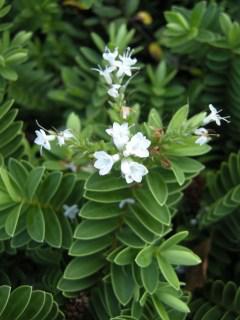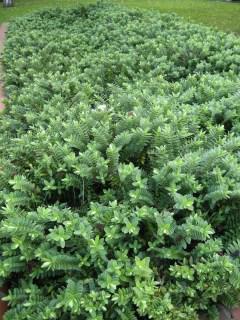
Hebe rakaiensis flower (13/11/2011, London)
Position: Full Sun to Partial Shade
Flowering Period: Summer
Soil: Well Drained, Moist
Eventual Height: 1m
Eventual Spread: 1.5m
Hardiness: USDA Zone 8a – 10b
Family: Scrophulariaceae
Hebe rakaiensis is a dwarf, evergreen shrub with a bushy, hummock shaped growth habit. The leaves of the plant are glossy on the upper surface and are bright green in color. They are spear-shaped, up to 2 cm long and are paired simple leaves. The hermaphrodite white flowers are racemes or spikes of small 4 lobed tubular to salver shaped flowers and appear in summer.
Hebe rakaiensis, commonly known as the Rakai Hebe or Shrubby Veronica, is native to New Zealand, Rapa in French Polynesia, the Falkland Islands and South America.
The etymological root of the binomial name Hebe is derived from the Greek Goddess of youth. Rakaiensis is a Latinized term meaning ‘from the Rakai Valley’ in New Zealand.

Hebe rakaiensis (13/11/2011, London)
Hebe rakaiensis may be useful to the landscape architect as a low growing evergreen shrub. It may be clipped to a low formal hedge, similar to Box. It is suitable for planting in coastal locations and in dappled shade. It is tolerant of some pollution.
The Royal Horticultural Society has given H. rakaiensis their it their prestigious award of Garden Merit in 1993.
H. rakaiensis prefers moist to well drained soil and can tolerate most soil pH levels although it prefers moderately alkali to neutral soils. It grows well in poor to moderately fertile soil.
Ecologically, H. rakaiensis is attractive butterflies and bees.
Maintenance: This plant requires little maintenance.

